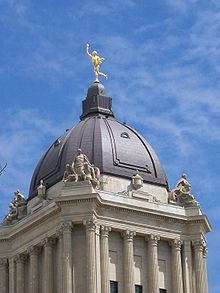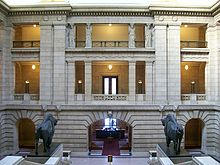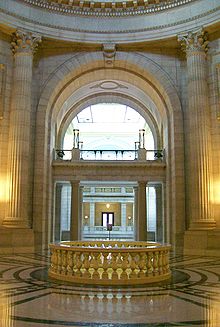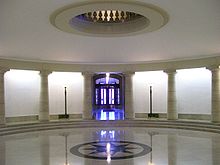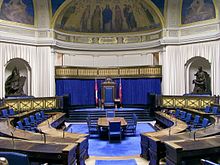- Manitoba Legislative Building
-
Manitoba Legislative Building 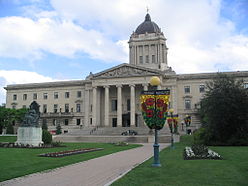
General information Town or city 450 Broadway,
Winnipeg, ManitobaCountry Canada Construction started 1913 Cost CDN$ 8,075,865 (1921 est.)[1] Height 242 ft Technical details Floor area 250,000 ft2 Design and construction Architect Frank Worthington Simon & Henry Boddington III The Manitoba Legislative Building is the meeting place of the Legislative Assembly of Manitoba,[2] in central Winnipeg, Manitoba, Canada. It was originally named the Manitoba Parliament Building, not Legislative.[2] The neoclassical building was completed in 1920 and stands seventy-seven meters tall (253 ft).[2] It was designed and built by Frank Worthington Simon (1862-1933)[3] and Henry Boddington III, along with other masons and many skilled craftsmen. The building is famous for the Golden Boy, a gold covered bronze statue based on the style of the Roman god Mercury, or the Greek god Hermes, at the top of the cupola, or domed ceiling.
The Manitoba Legislative Building is open every day of the year (including Saturdays and Sundays) for self-guided tours, and guided tours are available. [4]
Contents
History and construction
In 1911, the Manitoba government announced an architectural competition to all architects in the British Empire, with a grand prize of $10,000 was offered for the best design for the new Manitoba Legislative Building.[2] It is the third building used by Manitoba's legislative assembly,[2] the first being the home of A.G.B. Bannatyne, while the second stood on the same grounds as the current Legislative building.[2] Of the 67 submissions, Frank Worthington Simon, a former student at the Ecole des Beaux-Arts, had his design chosen for the construction of the impressive structure.[2][3]
Construction began in 1913, with Tyndall stone, quarried at Garson, about 20 kilometres northeast of Winnipeg.[2] On June 3, 1914 the north-east cornerstone ceremony, which was commonly done by masons, was laid by Thomas Kelly, the contractor. Kelly stole many of the materials to build his own house three blocks away, so the construction of the massive building was slowed and was not ready for partial occupancy until 1919.[2] On July 15, 1920, the province's 50th anniversary date, opening ceremonies were performed by Sir James Aikins, then Lieutenant-Governor of Manitoba.[2]
The base of the building forms the letter H.[2] The total square footage of the building is 250,000 square feet (23,000 m2), with a total height of 242 feet (74 m) above ground level toped with a bronze statue, gilded with 23.75 k gold leaf, of the Greek God Hermes or the Roman God Mercury.[2] The Legislative grounds cover 30 acres (120,000 m2) of landscaped grounds.[2] Throughout the exterior and interior of the building are examples of Fibonacci Sequence, Golden Ratio and Sacred Geometry.
Exterior
Coming up to the north side of the Legislative Building, above the 6 main columns, is the main pediment.[5] In the bottom-left corner of the pediment is the Indolent Man, with a half-kneeling woman, the spirit of progress, beckoning the Indolent Man into the new land of promise.[5] Next is the goddess Europa leading a bull, symbolizing Canada's European heritage and immigration.[5] To the right of Europa, a man, woman and child symbolizing the colonization of a new land.[5] Seated in the centre is Lady Manitoba with the rays of the sun behind her.[5] She closely resembles the fertility goddesses Ishtar and Demeter, both patron deities of agriculture, with Neptune's trident symbolizing the Pacific Ocean, and to the left and to the right are ships wheels symbolizing the Atlantic Ocean. Next to the right of Lady Manitoba are a man and a woman laden with wheat and fruit, products of the soil.[5] Then next is a muscular male figure with a team of powerful horses and a primitive plough tilling the soil.[5] Finally in the bottom right corner are two entwined female figures representing the Red and Assiniboine Rivers.[5]
Above the main pediment, flanking both sides are two Egyptian sphinxes facing both east and west.[5] Carved onto a flat piece of stone, just below the chin, in Egyptian hieroglyphics, is "The everlasting manifestation of the Sun God Ra, the good God who gives life."
On both the east and west porticos sit figures representing war and peace. On the east side, with engraved images of weapons of war, are two male figures, one a native warrior with an eagle head-dress, another a Roman soldier, and on the west side there are two female figures for peace. Each pair guards a chest, rumoured to represent the Ark of the Covenant because of the proper proportions as mentioned in the ancient Hebrew texts.
On the grounds of the Legislative Building, facing the Assiniboine River, there is the Louis-Riel sculpture by Miguel Joyal. It was erected in 1996 and commemorates Métis leader Louis Riel.
The Golden Boy
Main article: Golden Boy (Manitoba)Each one of the four corners of the copper dome supporting the Golden Boy has a stonework grouping representing the four elements of alchemy, earth, air, fire and water. They are identified as Agriculture, Science, Industry and Art.[5] The dome is 223 feet 7 inches (68.15 m) above the main floor. The height of the central tower without the Golden Boy is 242 feet (74 m). The statue was first installed in 1919, originally called Eternal Youth, and sculpted by Parisian artist Georges Gardet. The Golden Boy was last regilded and refurbished in 2002, and is illuminated by floodlights.
Grand Staircase
Within the main entrance is the Grand Staircase. This is a perfectly square room measuring 66.6 feet (20.3 m) on each side, which is meant to represent the numerological number 666, which are all the numbers added from one to 36, which is the square of 6, in mathematics, geometry, and arithmetic. The stair case is composed of three flights of steps each with 13 steps.[6] The steps are brown-veined Carrara marble,[6] the finest marble in the world. Flanking the steps are life size North American bison.[6] Made of solid bronze,[6] they were modelled by Georges Gardet, creator of the Golden Boy,[7] and cast at the Roman Bronze Works in New York City.[6] Each bison weighs 2,268 kilograms (2½ tons).[6] Legend has it that to install the bison safely without damaging the marble floors, the main entrance was flooded and left to freeze. Both bison were then placed on enormous slabs of ice cut from the Assiniboine River, and safely slid into the building.[6] The bison are one example of apotropaic icons in the Grand Staircase.
The bison, a symbol of the Province of Manitoba, are meant to represent the sacred bulls which guard temple entrances. Above the south entrance to the legislature lobby is the Medusa's head, and over the north entrance facing Medusa is the bust of Athena, Greek goddess of war, embodiment of democracy and also the protector of cities. Around the perimeter of the room are 14 lion heads and 8 cattle skulls at the edge of the ceiling. Around the second floor balcony, lamps rise from the balustrades,[6] each containing 13 bulbs, 12 around 1 (Twelve Apostles and Jesus). The third floor facing the Grand Staircase is supported by two pairs of columns, reproductions of the caryatids,[6] sculpted female figures serving as an architectural support taking the place of a column or a pillar. Each figure holds a scroll and key. The figures located on the third floor were carved by the Piccirilli Brothers of New York,[6] using models prepared by Albert Hodge of London, England. The ceiling is made of a glass atrium to allow natural sunlight to illuminate the room.[6]
Rotunda
The antechamber at the head of the grand staircase provides a formal approach to the legislative chamber.[8] 8 Corinthian columns rise from the floor to the cornice surrounding the base of the dome.[8] Between each pair of columns are busts of Hermes. The floor of the dome rotunda is Tennessee marble bordered with black Vermont and verde antique marble.[8] The height to the eye of the dome is 87 feet (27 m) and the diameter is 54 feet (16 m). Within the dome above are four panels containing 5 gold rosettes. In the centre of the Rotunda is an Italian marble balustrade 13 feet (4.0 m) across surrounding the Pool of the Black Star on the floor of the level below, a representation of the altars of the ancient Greeks. The diameter of the circle above the balustrade is also 13 feet (4.0 m), and both align with the Golden Boy above these. Above the doorway to the Manitoba Assembly is a mural by Frank Brangwyn depicting World War I.[8] In the centre of the painting is a man in tattered rags with his left chest and arm exposed, being helped along by a comrade. Above the men are a faint depiction of The Madonna and child.
Pool of the Black Star
The Pool of the Black Star is the room below the Rotunda with four entrances and marked by 3 steps forming a circumference of the room. The room is circular with a radius of 27 feet (8.2 m). At the centre of the floor is an 8-pointed black marble star. Directly above in alignment with the Pool of the Black Star is the dome of the building, on which the Golden Boy is mounted. The design of the building allows sounds from all over the building to be caught and heard in the circular room, and echoes can be heard by speaking in the room.
Lieutenant-Governor's Reception Room
In the east corridor of the Manitoba Legislative Building is the Lieutenant-Governor's Reception Room. This finely decorated room is used by the Lieutenant-Governor on state occasions to receive visiting royalty and foreign dignitaries and general public is barred from entry. During such events, scarlet-coated Royal Canadian Mounted Police are posted on either side of the door and military aides assist the Lieutenant-Governor with official duties. The room is panelled in black American walnut inlaid with ebony, and decorated with hand-carved ornaments around the ceiling and along the four corner pillars. Pictures of sovereigns grace the walls and a French gilt chandelier hangs from the ceiling. The floor features a carpet specially hand-woven in Donegal, Ireland. Facing across from each other on the north and south wall are two elaborate mirrors in gilt frames. The room measures 24 feet (7.3 m) in both directions. Directly above the Lieutenant-Governor's Reception Room are the two male warriors (War), one native in full eagle feathered head dress, and one Roman, guarding the representation of the Ark of the Covenant.
Legislative Chamber
The Legislative Assembly of Manitoba and the Lieutenant Governor form the Legislature of Manitoba, the legislative branch of government in the Canadian Province of Manitoba. Fifty-seven members are elected to this assembly in provincial general elections, all in single-member constituencies with first-past-the-post voting.[9] Originally, in 1870, there were 24 Members of the Legislative Assembly (MLAs).[9] As the province grew in population and size, more electoral divisions were added.[9] Winnipeg was once the third largest city in Canada, and often called Chicago of the North.[9]
Manitoba's Legislative chamber is unique among Provincial Legislatures in that the Members' benches are grouped in a horseshoe shape.[9] The Speaker of the House's chair is located on the south wall below the press gallery of 13 seats.[9] All debate is addressed to the Speaker, who rules on points of order and procedure and has the responsibility of maintaining order and decorum.
When the Legislature is in session, each day begins in accordance with procedures that have origins in the early beginnings of Parliamentary rule.[9] The speaker enters the Legislative Chamber followed by the clerks of the Legislative Assembly and preceded by the Sergeant-at-arms bearing Manitoba's Mace.[9]
The original desks and chairs of the Chamber are fashioned of walnut with inlaid ebony.[9] They are arranged in three tiers rising from a sunken floor in the centre of the Chamber.[9] Each desk is equipped with a microphone connected to a public address system and a recording machine used in the publication of Hansard, a verbatim report of debates and proceedings in the Legislature.[9] During question period, translators provide simultaneous translation from French to English.[9] The Chamber is also equipped for video and internet broadcasts of question period and special events such as throne and budget speeches.[9] Yet even as such changes have brought the assembly into the future, the original inkwells employed by an earlier generation of Manitoban politicians are still visible.[9] To the right of the speaker is a statue of Moses holding the Ten Commandments, to the left is Solon, a famous lawmaker of ancient Athens. Each statue is made of bronze and sculpted by Gardet.
Today
The cost of reconstruction today would be prohibitive, due to such factors as a shortage of skilled masons.[2]
A book was published in 2007 entitled The Hermetic Code, by Frank Albo,[10] which details the Masonic and classical history incorporated into the building.
References
- ^ W. C. Brisbin et al, Geology of the Manitoba Legislative Building, in Geoscience Canada Volume 32 Number 4, December 2005 , page 179 retrieved 2011 July 14
- ^ a b c d e f g h i j k l m n "The History", at the Legislative Tour, Province of Manitoba.
- ^ a b "Frank Lewis Worthington Simon", at Dictionary of Scottish Architects.
- ^ THE MANITOBA LEGISLATIVE BUILDING VISITOR TOUR PROGRAM - HOURS OF OPERATION
- ^ a b c d e f g h i j "The Exterior", at the Legislative Tour, Province of Manitoba.
- ^ a b c d e f g h i j k "The Interior", at the Legislative Tour, Province of Manitoba.
- ^ "Golden Boy", at the Legislative Tour, Province of Manitoba.
- ^ a b c d "The Rotunda", at the Legislative Tour, Province of Manitoba.
- ^ a b c d e f g h i j k l m n "The Legislative Chamber", at the Legislative Tour, Province of Manitoba.
- ^ Albo, Frank (April 2007). The Hermetic Code. Winnipeg Free Press. ISBN 0968257534.
External links
- Legislative tour at the Province of Manitoba
- Manitoba Legislative Building at emporis.com
- A Report on the Manitoba Legislature- Metaphor for Occult Thought?
- Researcher probes occult at Manitoba legislature CTV, Feb. 17 2005 10:28 PM ET
- www.FrankAlbo.com
- Manitoba, eh?!
Coordinates: 49°53′04″N 97°08′49″W / 49.884394°N 97.146918°W
Categories:- Buildings and structures in Winnipeg
- Legislative buildings in Canada
- Buildings and structures completed in 1920
- Beaux-Arts architecture in Canada
- Legislative Assembly of Manitoba
- Terminating vistas in Canada
Wikimedia Foundation. 2010.

